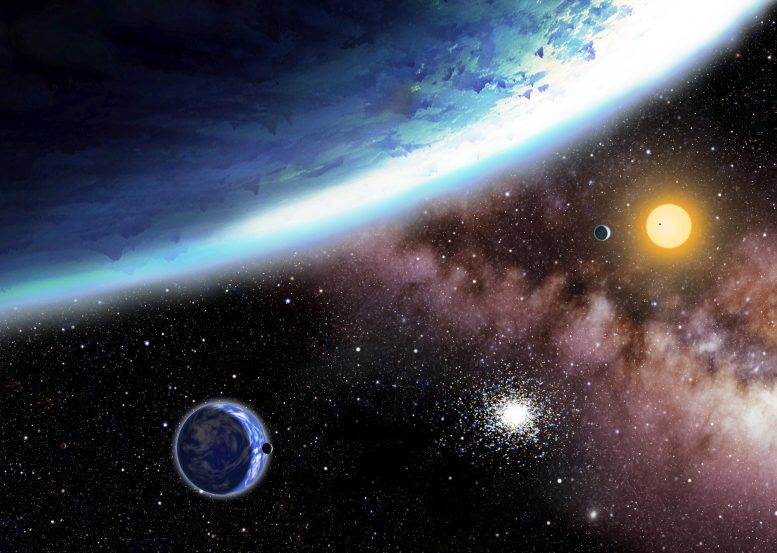
The newly discovered planets named Kepler-62e and -f are super-Earths in the habitable zone of a distant sun-like star. The largest planet in the image, Kepler-62f, is farthest from its star and covered by ice. Kepler-62e, in the foreground, is nearer to its star and covered by dense clouds. Closer in to the star orbits a Neptune-size ice giant with another small planet transiting its star. Both habitable-zone planets may be capable of supporting life. Credit: David A. Aguilar (CfA)
In a new paper, astronomers explore the properties Kelper 62e and 62f, which are part of the five-planet system orbiting the star Kepler-62, suggesting that both planets are water worlds and the first viable candidates for a habitable zone water planet.
In our solar system, only one planet is blessed with an ocean: Earth. Our home world is a rare, blue jewel compared to the deserts of Mercury, Venus and Mars. But what if our Sun had not one but two habitable ocean worlds?
Astronomers have found such a planetary system orbiting the star Kepler-62. This five-planet system has two worlds in the habitable zone – the distance from their star at which they receive enough light and warmth for liquid water to theoretically exist on their surfaces. Modeling by researchers at the Harvard-Smithsonian Center for Astrophysics (CfA) suggests that both planets are water worlds, their surfaces completely covered by a global ocean with no land in sight.
“These planets are unlike anything in our solar system. They have endless oceans,” said lead author Lisa Kaltenegger of the Max Planck Institute for Astronomy and the CfA. “There may be life there, but could it be technology-based like ours? Life on these worlds would be under water with no easy access to metals, to electricity, or fire for metallurgy. Nonetheless, these worlds will still be beautiful blue planets circling an orange star — and maybe life’s inventiveness to get to a technology stage will surprise us.”
Kepler-62 is a type K star slightly smaller and cooler than our Sun. The two water worlds, designated Kepler-62e and -62f, orbit the star every 122 and 267 days, respectively.
They were found by NASA’s Kepler spacecraft, which detects planets that transit or cross the face of their host star. Measuring a transit tells astronomers the size of the planet relative to its star.
Kepler-62e is 60 percent larger than the Earth while Kepler-62f is about 40 percent larger, making both of them “super-Earths.” They are too small for their masses to be measured, but astronomers expect them to be composed of rock and water, without a significant gaseous envelope.
As the warmer of the two worlds, Kepler-62e would have a bit more clouds than Earth according to computer models. More distant Kepler-62f would need the greenhouse effect from plenty of carbon dioxide to warm it enough to host an ocean. Otherwise, it might become an ice-covered snowball.
“Kepler-62e probably has a very cloudy sky and is warm and humid all the way to the polar regions. Kepler-62f would be cooler, but still potentially life-friendly,” said Harvard astronomer and co-author Dimitar Sasselov.
“The good news is – the two would exhibit distinctly different colors and make our search for signatures of life easier on such planets in the near future,” he added.
The discovery raises the intriguing possibility that some star in our galaxy might be circled by two Earth-like worlds — planets with oceans and continents, where technologically advanced life could develop.
“Imagine looking through a telescope to see another world with life just a few million miles from your own. Or, having the capability to travel between them on a regular basis. I can’t think of a more powerful motivation to become a space-faring society,” said Sasselov.
Kaltenegger and Sasselov’s research has been accepted for publication in The Astrophysical Journal.
Reference: “Water Planets in the Habitable Zone: Atmospheric Chemistry, Observable Features, and the case of Kepler-62e and -62f” by L. Kaltenegger, D. Sasselov and S. Rugheimer, 18 September 2013, The Astrophysical Journal.
DOI: 10.1088/2041-8205/775/2/L47
Headquartered in Cambridge, Mass., the Harvard-Smithsonian Center for Astrophysics (CfA) is a joint collaboration between the Smithsonian Astrophysical Observatory and the Harvard College Observatory. CfA scientists, organized into six research divisions, study the origin, evolution, and ultimate fate of the universe.



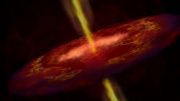

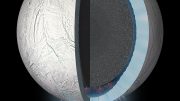
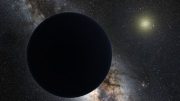

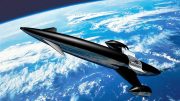
Water doesn’t = Life! It just sustains it after it has come into being.
I just wish those involve would stop ‘Conning’ the Public into thinking that there is Life on other planets when there isn’t.
Peter,
What convinces you that life on other planets does not exist? Have you been to all of them? I can tell you life on other planets does exist, as I am living proof. I am only here for a short while, but I will drop by your home some evening to convince you that you are quite wrong.
Your friend,
Grakli
if you are living proof that life on other planets does excist take me with you to your home world!!!!!!!!!!!!!!!!1
Peter is a troll so ignore him
Peter you’re a real @sshole how do you know there isn’t? Do ya ever been on those planets? No you haven’t so stop act like a stuck-up snob
If there is no life anywhere else in the Universe that sure is a large waste of space out there. And we as humans sure have to be pretty arrogant to imagine we are that lucky to be the only ones out here. I just hope in my life time we discover something amazing out there. See something. It is just exciting. No need to be a downer is it.
Our own world will one day be completely covered in water. It is quite likely our own species originated from some other planet that we wrecked with our so called technology. We are, after all, the only species on this planet that doesn’t belong here. Humanity has indeed proven to be a cancer. I sincerely hope that IF some other space faring species finds us before we develop the crude and wasteful human means to venture to some other clean, habitable planet they exterminate the human species altogether. It is overrun and controlled by greedy warmongers and idiots who halt the progression of clean energy research so they don’t lose meaningless money. DESTROY ALL HUMANS!!
You do realize that means that you are asking for yourself to be destroyed, right? Idiot.
Unless he’s not human.
maybe he doesnt care… idiot. he has a point. an extreme one, but one nonetheless.
Logan… you win the dumbest person on the comments section award. Congrats
I agree with you Logan. Maybe the destroy humans thing was a little much, but I understood.
It’s not a matter of if, it’s a matter of where. With Trillions upon Trillions of planets in the universe, saying that only one will have the complex self-replicating chemical reactions we call life is ignorant. And it doesn’t have to be life with liquid water. A group of chemistry-focused astrologists have found a theoretical model for life using liquid methane as a replacement for water. Interestingly, the moon Titan has the necessary seas of liquid methane and organic molecules for that sort of life… For more info Google “Azotosome” It’s quite possible that Kepler 62 planets also have life, but water-based, like Earthlife an not Titanlife (if it exists). Bigger telescopes and more research and maybe another mission to Titan is needed to confirm or disprove our speculations. So let’s save the TMT from its opponents so we can use it to look for signs of life in the galaxy and beyond.